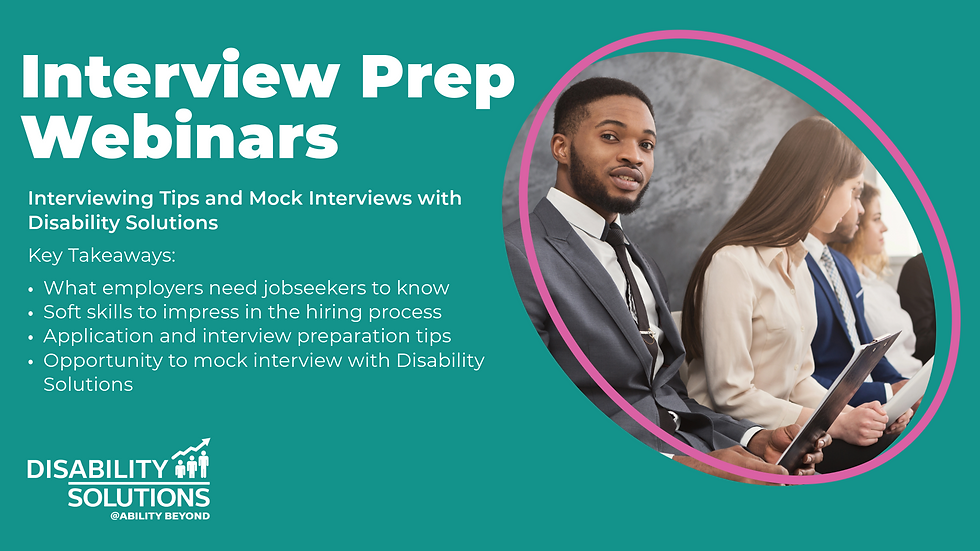A 10-Step Job Search Readiness Checklist: Prepare, Apply, Succeed
- Ashley Sims

- Aug 13
- 6 min read
Updated: Aug 20
The job market is more competitive than ever. With increasing automation, shifts in hiring trends, and tighter budgets across industries, landing the right opportunity can be tough—especially for job seekers with disabilities who often face additional barriers in the hiring process. Many roles receive hundreds of applications, and the path from resume to interview can feel uncertain and exhausting.
Getting ready for your job search can feel overwhelming—but with the right strategy, tools, and preparation, you can confidently pursue opportunities with inclusive employers who value your skills, experience, and unique perspective.
Whether you're looking for your first role, making a career change, or re-entering the workforce after time away, this comprehensive readiness checklist is designed to help you stay focused, proactive, and competitive. These practical steps will help you stand out, communicate your strengths clearly, and make meaningful connections with employers who are committed to accessibility and inclusion.

✅ 1. Update Your Resume
Your resume is your personal marketing tool—it should clearly tell your story and align with the roles you're targeting.
Tips:
Add your most recent experiences, certifications, training, and accomplishments.
Use action-oriented language to highlight impact (e.g., "managed," "designed," "implemented").
Tailor your resume for each job application using keywords from the job posting.
Ensure formatting is clean, consistent, and accessible (consider using accessible resume templates).
Tools like Jobscan can help tailor your resume for each position and optimize it for applicant tracking systems (ATS).
✅ 2. Refresh Your LinkedIn Profile
A strong LinkedIn presence increases your visibility and helps employers find you.
Tips:
Update your headline to reflect your professional goals and key skills.
Rewrite your summary to showcase your strengths, values, and aspirations.
List relevant skills and get endorsements from peers or mentors.
Upload a professional profile picture and customized background image.
Follow companies committed to disability inclusion.
Turn on “Open to Work” and actively connect with recruiters and professionals in your field.
✅ 3. Learn About Your Rights and Available Resources
Being informed empowers you to advocate for yourself during the job search and beyond.
Tips:
Review your rights under the Americans with Disabilities Act (ADA).
Know how to request reasonable accommodations during the application or interview process.
Explore programs like:
Access support through Disability Solutions and partner organizations specializing in inclusive hiring.
✅ 4. Build a Personal Routine for Job Search Success
Consistency and structure can make the job search process less stressful.
Tips:
Set daily or weekly goals (e.g., apply to 3 jobs, attend one networking event, update one part of your resume).
Create a spreadsheet to track applications, contacts, and follow-ups.
Schedule breaks to avoid burnout and prioritize self-care during your search.
✅ 5. Practice Interview Skills
Interviewing is a skill—and like any skill, practice builds confidence.
Tips:
Learn and practice using the S-T-A-R method (Situation, Task, Action, Result) and S-E-T (situation, effect, takeaway) to answer behavioral questions effectively. Get a full breakdown of these methods.
Record yourself or practice with a friend, mentor, or job coach.
Sign up for live weekly Interview Prep Webinars, hosted by Disability Solutions.
Prepare responses for common questions like:
"Tell me about yourself."
"Why do you want to work here?"
"Describe a time you overcame a challenge."
Research each company thoroughly before your interview. Know their mission, values, and what they’re looking for in a candidate.
Consider how and when you’d like to disclose a disability (if at all), and know your rights when requesting accommodations.
Bonus: Register for Interview Prep Training through Disability Solutions for expert support.
✅ 6. Attend Job Fairs & Virtual Hiring Events
Job fairs are great for making connections and learning about opportunities—many are now fully virtual and accessible.
Tips:
Research participating employers ahead of time and prioritize who you want to meet.
Prepare a 30-second elevator pitch summarizing your background, goals, and what makes you unique.
Dress professionally (even for virtual events) and check your tech setup in advance.
Follow up with recruiters after the event with a thank-you email or LinkedIn message.
📌 Disability Solutions' Virtual Career Fair | October 8, 2025 | 11 AM- 4 PM EST
📌 Stay up to date on all upcoming events
✅ 7. Network with Purpose
Networking isn't just about finding jobs—it's about building meaningful professional relationships.
Tips:
Join LinkedIn groups, disability-focused job communities, and professional associations.
Attend industry webinars, panel discussions, and meetups (virtually or in-person).
Purplespace is a networking and professional development hub for people with disabilities
Don’t hesitate to reach out for informational interviews with people in your target field.
✅ 8. Follow Up and Make Direct Connections
Don’t let all those applications and networking events go to waste—proactive communication can set you apart from other candidates.
Tips:
After submitting your application, try to identify the recruiter or hiring manager associated with the role.
Send a personalized LinkedIn message or a brief, professional email expressing your interest in the position and the company.
Mention something specific that connects your background to the role or company’s mission—it shows genuine interest and effort.
If you’ve met a recruiter at a job fair or virtual event, send a quick follow-up message thanking them and reiterating your enthusiasm.
Keep your message short, friendly, and professional. You’re not asking for a job—you’re opening a door.
Example LinkedIn DM:
Hi [Name], I recently applied for the [Job Title] role at [Company Name] and was really excited about the position because [insert why you are excited for the job-include reference to your experience, etc.] I’d love to connect and learn more about the team. Thank you for your time!
Why it matters: Recruiters and hiring managers are more likely to engage with candidates who take initiative. A thoughtful follow-up can make you memorable and move your name to the top of the list.
✅ 9. Set the Stage for Interview Success
Your environment and tech setup can make or break a great interview—especially in today’s remote and hybrid hiring landscape. Taking time to prepare both your space and tools shows professionalism and helps you focus on what really matters: making a strong impression.
Tips:
Test your technology in advance: Check your internet connection, webcam, microphone, and any assistive tech you use. Run a practice call on platforms like Zoom, Microsoft Teams, or Google Meet.
Choose a quiet, well-lit space with minimal distractions. A clean, neutral background keeps the focus on you.
Set up a “cheat sheet” nearby: Prepare your resume, job description, key talking points, and questions you want to ask the interviewer—easily viewable but out of frame.
Dress professionally, even for video interviews. First impressions still count, even on screen.
Have a backup plan in case of tech issues—like a phone number to call or a hotspot connection.
Why it matters:Being prepared for the logistics of the interview allows you to focus on what matters most—telling your story, highlighting your strengths, and building a connection with the employer.
✅ 10. Ask Smart Questions, Make a Strong Impression
The first interview—often a phone or video screening—is your chance to make a strong first impression and gather key insights about the role. It’s not just about answering questions—it’s also about asking the right ones.
Tips:
Be ready to talk about your resume, relevant experience, and why you’re interested in the role.
Practice answering common screening questions (see step 5)
Have your own questions ready that demonstrate curiosity, strategic thinking, and alignment with the role.
Ask thoughtful, targeted questions like:
“Why is this position open, and why are you considering external candidates?”This can give you insight into the team’s structure, growth, or challenges.
“What skills or experience is the current team missing, and how could someone in this role fill that gap?”Use their response to highlight how your experience directly addresses their needs.
“Can you share the salary range for this position and the expected timeline for next steps in the hiring process?”Asking early shows you respect both your time and theirs, and helps set realistic expectations.
Why it matters: These early conversations are an opportunity to position yourself as a problem-solver, not just a job seeker. They also help you evaluate if the company and role are truly the right fit for you.
📌 Bonus: Stay organized and go into interviews prepared and ready to negotiate with these 5 tips.
You're Not Alone
Job searching can be tough—especially in today’s competitive market—but every step forward counts. Whether you're updating your resume, practicing interviews, or sending a follow-up message to a recruiter, you’re actively building momentum toward your next opportunity.
🌟 Stay Positive
The process may take time, but persistence and self-care go a long way.
Here are a few ways to stay grounded and motivated:
Celebrate small wins—like submitting an application, landing an interview, or making a new professional connection.
Reflect on feedback (when you receive it) and use it to improve your approach.
Stay connected with mentors, job coaches, online communities, or peers who understand your journey.
At DisabilityTalent.org, we believe every job seeker deserves equal access to opportunity, support, and inclusive employment. Use this checklist as a roadmap to help you prepare, apply, and thrive in roles where you’re truly valued.
📩 Need help along the way? Get more resources, tools, and insider tips on our Job Seeker Resource page.



































Comments